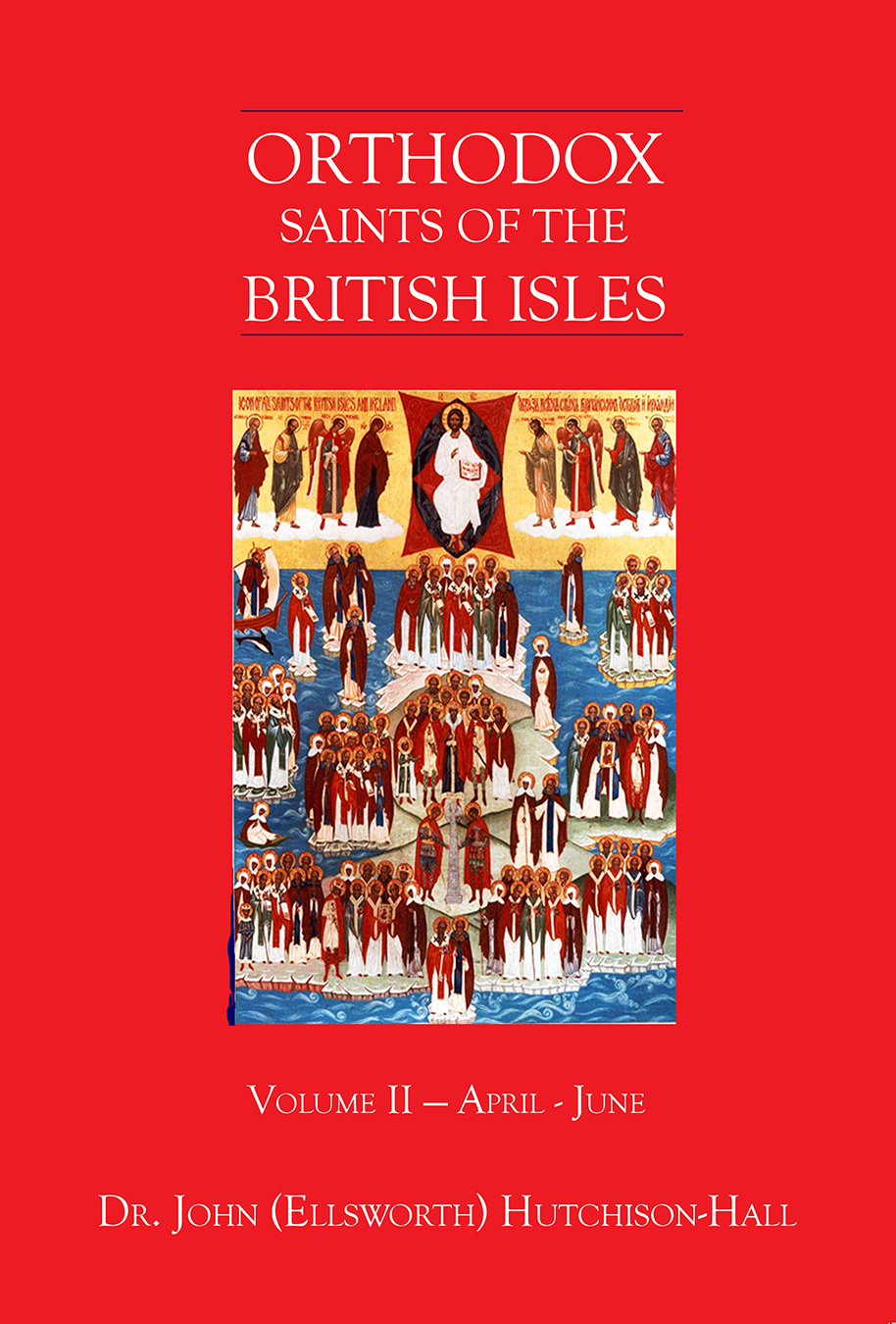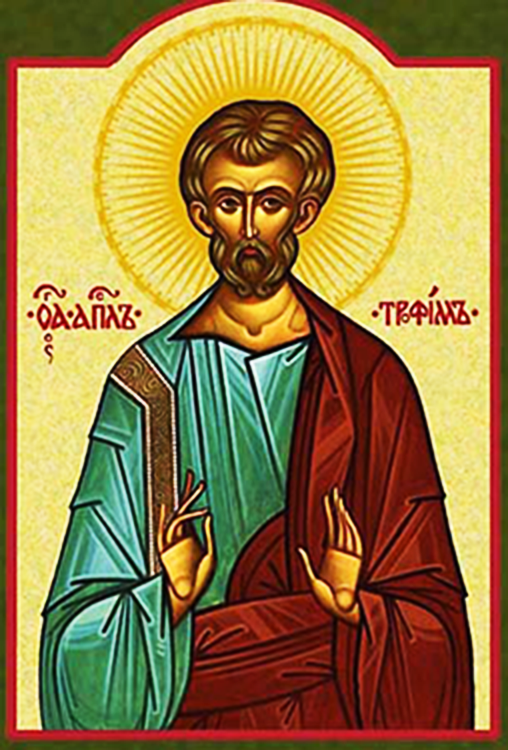
Orthodox Saints of the Pre-Schism
See of Rome
29th April (NS) — 16th April (OS) 2023
ELIAS, an Irishman who was made Abbot of the Celtic Abbey of St. Martin the Great (abtei Groß St. Martin) in Cologne in present-day North Rhine-Westphalia, Germany (circa 1020), and later the Archbishop of Cologne appointed him Abbot of the Abbey of St. Pantaleon, also in Cologne, as well. St. Elias reposed in 1042.
ENCRATIA (ENCRATIS, ENCRATIDE, ENGRACIA) of ZARAGOZA, a maiden who fled marriage in her native Portugal to live as a monastic in Zaragoza in present-day Aragon, Spain. There she was subjected to severe torture, most likely during the Diocletianic Persecution (303–313), though she survived her torture, St. Encraia is still counted amongst the martyrs. However, her name is absent from the lists of the martyrs of Zaragoza of that era.
FRUCTUOSUS of BRAGA, a prince of the Visigoth royal family, who upon the death of his parents, sold his assets, giving most to the poor. With the balance of his funds, St. Fructuosus built several monasteries, serving as abbot of one. However, he felt his duties were drawing him away from God, so left to live as a hermit. His reputation for holiness led to him attracting many disciples, and being ordered by his bishop to accept consecration as the Bishop of Dumium near Braga, Portugal, and roughly two years later elevation to Archbishop of Braga. St. Fructuosus reposed in 665.
HERVEUS (HERVÉ) of TOURS, a monk at the Abbey of Marmoutier (abbaye de Marmoutier) in Tours (France), and though a member of the community, St. Herveus lived as a hermit. He reposed in 1021.
LAMBERT of ZARAGOZA, there are two St. Lamberts of Zaragoza (in present-day Aragon, Spain) commemorated on this day. The first who managed to survive the Diocletianic Persecution (303–313), only to be martyred by pagans in 306. The second St. Lambert was a servant martyred by his Muslim master circa 900.
PATERNUS (PAIR) of AVRANCHES, this Saint Paternus’ life is somewhat entangled with those of 15th April, especially St. Paternus / Padarn. Today’s St. Paternus, is said to have been the son of a son of a civil servant in Poitiers (western France), received monastic tonsure at an abbey in Poitou (present-day Nouvelle-Aquitaine, France), and after he had matured in the spiritual life, he settled near Coutances in Normandy (France) where he lived as a hermit. Later a monastery was built there and dedicated to him. It is believed St. Paternus was the founder of several monasteries, and abbot of one of them. At the age of seventy, he was consecrated Bishop of Avranches in Normandy, serving that See for thirteen years, until his repose which has been variously recorded as circa 550, 563, 568, and 574. As his birth is thought to have been circa 482, he was consecrated bishop at the age of seventy, which would have been circa 552, and served for thirteen years as bishop, it is reasonable to date his repose as being circa 565.
THE EIGHTEEN MARTYRS of ZARAGOZA: APODEMUS, CAECILIAN, CAIUS, CREMENTIUS, ENGRATIA, EVENTIUS, FELIX, FRONTO, GAIUS, JULIA, LAMBERT, LUPERCUS, MARTIAL, OPTATUS, PRIMITIVUS, PUBLIUS, QUINTILIAN, FOUR NAMED SATURNIUS, SUCCESUS, and URBAN, a group of eighteen martyrs at Zaragoza in present-day Aragon, Spain during the Diocletianic Persecution (303–313).
TURIBIUS of ASTORGA, an early Bishop of Astorga in north-western Hispania (present-day Spain). St. Turibius was known for his zealous opposition to Priscillianism, and his ardent support of Pope St. Leo the Great (10th November) battles against the various heresies that beset the Church. St. Turibius reposed circa 460.
VAISE (VASIUS, VAIZE), a wealthy Christian in Saintes in present-day south-western France. St. Vaise was imprisoned and later beheaded, circa 500, by his family for distributing his wealth to the poor.
Get your copy of Orthodox Saints of the British Isles today.
Available at Amazon or your favourite e-bookstore.
AGAPIUS and COMPANIONS (MARTYRS of CIRTA), a group of clergy and laity martyred in Cirta in Numidia (present-day Tunisia), during the persecutions under Emperor Valerian (r. 253–260). According to the Roman Martyrology those martyred with St. Agapius were: Antonia, Emilian, Secundinus, Tertula, and a woman and twin children whose names are no longer known.
AVA (AVIA) of DENAIN, a niece of Pepin the Short, King of the Franks (r. 751–768), who was miraculously healed by St. Rainfrede (8th October) of blindness which she had suffered since childhood. In time St. Ava, received monastic tonsure at Denain Abbey in Hainaut, present-day Belgium, and later served as its Abbess. St. Ava reposed circa 845.
DANIEL of GERONA, (Ninth Century), according to a legend of suspect veracity, St. Daniel was native of Asia Minor who became a hermit at an unknown location in present-day Spain. He is listed as a martyr, though the circumstances and location of his martyrdom are unknown.
DICHU (DICTINUS), (Fifth Century), St. Patrick's (17th March) first convert in Ireland, St. Dichu was the son of an Irish chieftain and a swineherd in his youth. He gave St. Patrick the land at Saul in Co. Down, Ireland for his first church.
ENDELLION (ENDELIENT, ENDELIENDA) of TREGONY, (Sixth Century?), St. Endellion was one of the daughters of St. Brychan of Brycheiniog (6th April) and sister of St. Nectan (17th June). According to legend she was the Goddaughter of King Arthur. St. Endellion lived as an anchorite in Cornwall, England and is commemorated by the church and village of St. Endellion in northern Cornwall, England.
FIACHAN (FIANCHNE) of LISMORE, (Seventh Century) , St. Fiachan was a monk under St. Carthage the Younger (14th May) at the famous Lismore Abbey in Co. Waterford, Ireland. He is especially remembered for his obedience and gift of prayer.
GUNDEBERT of GUMBER, (Eighth Century), the husband of St. Bertha (1st May) and brother of St. Nivard (1st September). Towards the end of his life, St. Gundebert separated from St. Bertha by mutual consent. He then went to Ireland where he received monastic tonsure. St. Gundebert met his martyrdom when his monastery was sacked by pagans, and he was killed.
PAULINUS of BRESCIA, a sixth century Bishop of Brescia in the northern Italian region of Lombardy. Consecrated circa 524, St. Paulinus served the See until his repose in 545.
SENAN of WALES, (Seventh Century), St. Senan was a hermit in northern Wales about whom there is no information extant.
SEVERUS of NAPLES, an early fifth century Bishop of Naples (Italy). A renowned wonderworker, St. Severus once brought a man back to life, so he could testify on behalf of his wife who was facing unfounded charges. St. Severus reposed in 409.
TORPES of PISA, although the subject of many early Lives, which are almost complete devoid of fact, little is actually known of St. Torpes. As far as is known he was martyred in Pisa, circa 65, during Emperor Nero's (r. 54–68) persecution of Christians. The town of Saint-Tropez in France is named for him.
WILFRID the YOUNGER, after receiving his education at Whitby Abbey in North Yorkshire, England, under St. Hilda (17th November), St. Wilfrid attached himself to St. John of Beverley (7th May). He later succeeded St. John as the last Bishop of York, England, as the See was elevated to an archbishopric during the time of his successor. St. Wilfrid resigned the See in 732, retiring to Ripon Abbey in North Yorkshire, England where he lived until his repose in 744. He was buried at Ripon Abbey, though it is possible his relics were later translated to Canterbury, England in the mistaken belief they were those of his more famous namesake (12th November).
Prior to the Schism the Patriarchate of Rome was Orthodox, and fully in communion with the Orthodox Church. As Saint John of Shanghai and San Francisco +1966 said “The West was Orthodox for a thousand years, and her venerable Liturgy is far older than any of her heresies”.
Details of British Saints excerpted from Orthodox Saints of the British Isles.
Details of continental saints from these sources.
In many cases there are several spelling versions of the names of saints from the British Isles. I use the Oxford Dictionary of National Biography version as the primary version with the more prevalent version in parenthesis e.g. Ceadda (Chad) of Lichfield.


